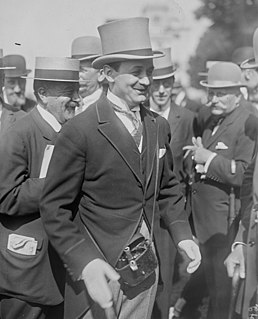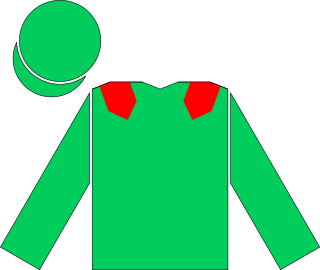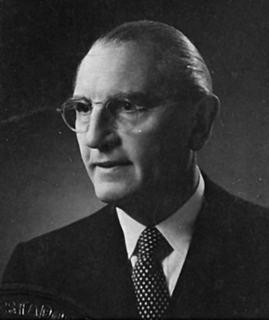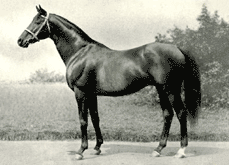Related Research Articles
Jean-Luc Lagardère was a major French businessman, CEO of the Lagardère Group, one of the largest French conglomerates.

Prince Shāh Karim al-Husayni, known by the religious title Mawlana Hazar Imam within Ismaili Shia circles and as Aga Khan IV elsewhere, is the 49th and current Imam of Nizari Ismailism, a denomination of Isma'ilism within Shia Islam. He has held this position of Imam since 11 July 1957, when, at the age of 20, he succeeded his grandfather, Sir Sultan Muhammad Shah Aga Khan III. Aga Khan claims to be a direct lineal descendant of the Islamic prophet Muhammad through Muhammad's cousin and son-in-law, Ali, considered Imam in Shia Islam, and Ali's wife Fatima, Muhammad's daughter from his first marriage.

Pont-d'Ouilly is a commune in the Calvados department in the Normandy region in northwestern France.

Marcel Boussac was a French entrepreneur best known for his ownership of the Maison Dior and one of the most successful thoroughbred race horse breeding farms in European history.

Dalakhani was an Irish thoroughbred race horse owned and bred by Aga Khan IV and trained by Alain de Royer-Dupré. He was sired by Darshaan covering Daltawa (Miswaki) and was therefore half-brother to Daylami.
Tantième (1947–1966) was a French Thoroughbred horse racing champion and prominent sire who twice won the Prix de l'Arc de Triomphe, France's most prestigious horse race. He also won several other important conditions races including the Grand Critérium in 1949, the Poule d'Essai des Poulains, Prix Lupin and his first Arc de Triomphe in 1950. Racing as a four-year-old, in 1951 Tantième won the Prix Ganay plus his second Arc de Triomphe and in England he captured the Coronation Cup.
Alain de Royer-Dupré is a leading French thoroughbred racehorse trainer.
Duke of Decazes, also called Duke Decazes, is a title of French nobility that was granted in 1820 to Élie Decazes, a French statesman who served as Prime Minister of France from November 19, 1819 to February 20, 1820. He had already been made a French count in 1816. Separately, he was given the hereditary Danish title of Duke of Glücksbierg upon his second marriage in 1818, which title was recognized in France in 1822.
Louis Jean Victor Sévère Decazes de Glücksbierg, 4th Duc Decazes and 4th Hertig af Glücksbierg, was a French businessman and Thoroughbred racehorse owner and breeder.

François Louis Jules Dupré was a French, hotelier, art collector, and owner of the thoroughbred horse breeding and racing farm, Haras d'Ouilly. He was a grandson of the painter Jules Dupré.

Prince Palatine (1908–1924) was a British Thoroughbred racehorse. He was named for County Palatine of Lancaster near where his breeder William Hall Walker had been raised.
Match (1958–1965) was a French Thoroughbred racehorse who won major races in England, France and the United States and who was voted British Horse of the Year. Like many French-bred horses, he carried the numerical suffix "II" when racing in Britain. Because another horse with the name Match was born registered in the United States that same year, he is sometimes recorded as "Match III."
Haras de Saint Pair du Mont is a Thoroughbred horse breeding farm at Le Cadran near Cambremer in Calvados, Normandy. The business was founded circa the 1880s by renowned horseman, Leonce Delatre whose estate sold the property to Evremond de Saint-Alary in the early 1890s. On his death in 1941, Saint-Alary left the property to a lady friend, Mademoiselle Frémont-Tousch. Following her death, the farm was acquired by Jean Stern. In 1971, Stern's daughter, Madame Sanjust di Teulada, took over management of the property and the following March at Auteuil Racecourse disposed of a large portion of the bloodstock. In 1998 a Swedish gentleman named Goranson purchased the farm which still operates to this day under the management of Thierry de Chambord.

Zarkava is an undefeated French Thoroughbred racehorse who won the 2008 Prix de l'Arc de Triomphe.

William Francis du Pont Jr. was an English-born, American businessman and banker, and a prominent figure in the sport of Thoroughbred horse racing. He developed and designed more than 20 racing venues, including Fair Hill at his 5,000-acre estate in Maryland. A member of the Delaware Du Pont family, he was the son of William du Pont and Annie Rogers Zinn, and brother to Marion duPont Scott, a noted horsewoman and breeder.
Chanteur was a French Thoroughbred racehorse and sire who was one of a group of French horses, including Caracalla, Marsyas, Arbar and Souverain, which dominated long-distance racing in Europe in the immediate post-war years. Unraced as a two-year-old, Chanteur won the Prix Hocquart in 1945 and the Prix Jean Prat in 1946. He reached his peak as a five-year-old when he won six races including the Prix des Sablons in France and the Coronation Cup in Britain. He was also placed in many important races including the Grand Prix de Paris, Prix de l'Arc de Triomphe, Prix Royal Oak, Prix du Cadran and Ascot Gold Cup. At the end of his racing career he was retired to stand as a breeding stallion in Britain, where he had considerable success as a sire of winners.
Mouktar was an Irish-bred, French-trained Thoroughbred racehorse and sire. Bred and owned by the Aga Khan, he was undefeated in his first five races including the Critérium de Saint-Cloud, Prix Greffulhe, Prix Hocquart and Prix du Jockey Club before finishing unplaced behind Law Society in the Irish Derby. He won the Prix Niel on his only subsequent appearance and was retired to stud at the end of his three-year-old season.
Vayrann was an Irish-bred, French-trained Thoroughbred racehorse and sire. As a three-year-old in 1981 he won four of his six races including the Prix Jean de Chaudenay, Prix du Prince d'Orange and Champion Stakes. His victory in the latter race was only confirmed at the end of a protracted and controversial process after he failed a post-race drug test. He was injured on his second appearance in 1982 and was retired to stud, where he had moderate success as a sire of winners.
Natroun was a French Thoroughbred racehorse and sire. Owned and bred by the Aga Khan IV and trained by Alain de Royer-Dupré he won three of five races as a three-year-old in 1987. Unraced as a two-year-old he won two minor races in the spring before recording his most important success in the Prix du Jockey Club. In his two remaining races he ran well when fourth under top weight in the Prix Niel and finished unplaced in the Prix de l'Arc de Triomphe. He was retired from racing at the end of the year to stand as a breeding stallion but had very little success as a sire of winners in either Europe or Japan.
Turkhan was a British Thoroughbred racehorse and sire, who raced during World War II and was best known for winning the classic St Leger in 1940. He showed good form as a two-year-old, winning the Coventry Stakes at Royal Ascot. In the following year he finished second in the rescheduled New Derby and won the Irish Derby before taking a substitute Yorkshire St Leger at Thirsk Racecourse in November. He was then retired to stud where he made little impact as a breeding stallion.
References
- Pont-d'Ouilly municipal website with the history of Haras d'Ouilly (French language)